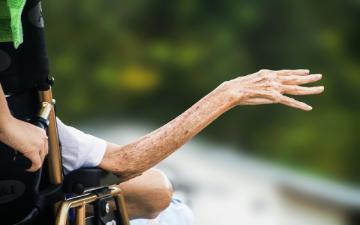
Anita Varma is the assistant director of Social Sector Ethics as well as Journalism & Media Ethics at the Markkula Center for Applied Ethics at Santa Clara University. Joan Harrington is the director of Social Sector Ethics at the Markkula Center for Applied Ethics at Santa Clara University. Views are their own.
Who does coronavirus affect most severely? Ready responses to this question might include the infirm and elderly, essential workers, racial minorities, people at risk of domestic violence and child abuse, and people facing food insecurity.
This list is extensive, but far from exhaustive. Ethical policy makers and analysts also need to consider people who remain out of most spotlights yet are profoundly affected by coronavirus and stay-at-home orders: namely, smaller communities that come together based on a shared injury, disability, or trauma—and the nonprofits who serve them.
For example, survivors of burn injuries, people who live with physical disabilities and their caregivers, and veterans who are at a soaring risk of suicide are just a few of the lesser-seen but no less vulnerable groups that have often fallen by the wayside in public discourse about the implications and impact of coronavirus.
These are three communities that nonprofits have dedicated missions to serve. In our capacity leading a social sector ethics program, we work with nonprofits of all sizes, many of whom provide services and support to communities that have been forgotten by much of the public and private sector.
These community nonprofits have seen their ability to fulfill their missions severely hindered or in some cases rendered impossible due to coronavirus. To make matters worse, donations and loans are dwindling, such that the nonprofit sector has had to furlough or lay off already-small staffs. Crestfallen, nonprofit leaders have shared with us how social distancing has limited or eliminated activities that these communities have come to cherish.
Restaurant outings with veterans to help them socially connect and feel supported, summer camps with supportive staff (which are a rare opportunity for people with special needs), and hospital visits to provide support to burn victims have all been rendered impossible or gravely inadvisable. Nonprofits need staff and time, and therefore money, to come up with new ways to support their constituents whose isolation pre-dates the pandemic and has been worsened by it.
Nonprofits exist in part to address the market failure that leads to services and resources either not being available or not being accessible to those who need them most. At the same time, nonprofits are by no means insulated from the market.
In the wake of the most recent market crash, philanthropy has responded generously to directly fighting the coronavirus. Global charitable giving has reached more than $10 billion, from corporate giving programs, corporate foundations, as well as family and individual foundations. Smaller gifts from individuals increase this number.
What happens, though, to the nonprofits that serve communities like at-risk veterans, burn survivors, and physically disabled children and adults—whose regular donor base may either redirect funds to front-line efforts or feel less inclined to give until their market portfolio improves?
In debates about ventilator allocations in bioethics circles last month, part of the discussion was about figuring out how to make decisions when not all patients will survive: do you save the youngest patient, the patient with the most dependents, or the patient in front of you? The same line of questioning is beginning to emerge as we assess the bleak outlook for many nonprofit organizations: should donations and funding flow to front-line organizations such as food banks and those involved in developing ways to treat the virus, to the largest organizations with greatest reach, or the organization that is geographically closest? Or should donors try to support a wide range of organizations that serve small, often suffering communities with no alternative options for services?
The answer is far from obvious. In resource-rich times, the answer would be “all of the above.” In lean times, though, and particularly as economic recession looms, we should consider not only the immediately visible communities in need but also those who suffer quietly and whose quality of life is being negatively impacted—and will worsen if nonprofits designed to serve them disappear.
